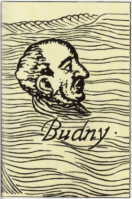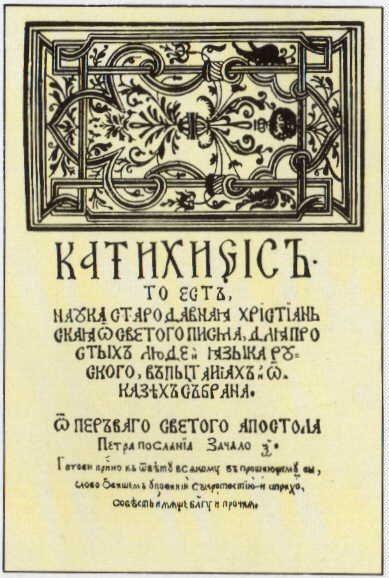![]()
 Symon Budny
Symon Budny Symon Budny was born in an Orthodox Christian family near Zabludnae and grew up at the court of Belarusian magnat family of Hadkevich. He had received his highest education in Krakow Academy. He was speaking Belarusian, Polish, Chech, Latin, Italian, Greek and Jewish (Hebrew?). His works have appeared in several languages including Belarusian. Besides Krakow he studied for some time in Italy and Switzerland.
After getting his education Symon Budny settled in Kleck in the court of Mikalaj Radzivil "Black", who was supporter of Calvinism. Here he worked on his "Cathehesis" and published it in 1562 in Niasvizh. The printing house in Niasvizh was organized by Astap Valpovich, Mikalaj Radzivil, Niasvizh burmistr (major) Macej Kavechynskij, Niasvizh calvinist priest Lauryn Kryshkouskij and Symon Budny himself, who was a Calvinist priest in Kleck. Soon after that Budny revealed his interest in socianism (aryanism), which he learned abroad. He had discussed socian ideas very cautiously in his work "O opravdanii greshnogo cheloveka pred Bogom"("On the justification of sinful men in front of God"). For this the Calvinist Assembly condemns him and takes off his priesthood. After this Symon Budny was caught in a desperate financial situation. He tried to turn back and reject socianism but he can't get back in favor of his former patron Radzivil. Finally he leaves for Losk seeking the patronage of Ian Kishka, a known patron of socianism. Here he is openly expressing his socian (aryan) ideas.
The socian ideas Budny has learned from a scientist and meical doctor Mihajla Servet. Mihajla Servet is known for his discovery of blood circulation in the human body. He has been executed in a fire by Calvinists for his critics against Calvin in Geneva in1553.
In his works Symon Budny is discussing the problems of politics and statehood, war and peace, the right of individual for freedom. He is speaking out against having death sentence in society. His independent thinking has become a target of hatred of both Orthodox Christians and Catholics.\
 In his
"Cathehesis" (printed in 1562, Niasvizh, in
Belarusian) Budny following Dr. Francysk Scaryna uses native Belarusian speech to explain
Christianity. It is written in a form of questions and answers, and consists of 4 parts:
on 10 amendments, on the symbol of belief, about praying to God and on the rituals. This
work was directed mainly against Orthodox Christianity. It is printed in Belarusian:
In his
"Cathehesis" (printed in 1562, Niasvizh, in
Belarusian) Budny following Dr. Francysk Scaryna uses native Belarusian speech to explain
Christianity. It is written in a form of questions and answers, and consists of 4 parts:
on 10 amendments, on the symbol of belief, about praying to God and on the rituals. This
work was directed mainly against Orthodox Christianity. It is printed in Belarusian:
"So that the Duchy Highness not only enjoyed foreign languages, but also would fall in love with the ancient Slavic language and enjoy it too... And so that all others would have follow the good example and the Fatherland and its native language would have future and hope". (free translation A.A.) The native Belarusan language in the state and religion was one of the main slogans of Belarusian Reformation. At their time, just like today Orthodox service was done in Old Slavic (close to Bulgarian) and Catholics were speaking Latin (later Polish). Amazingly the only religion that used Belarusian was Muslim - which could be seen in their texts (for example Al-Ketab in Vil'na) written in Belarusian with Arab letters.
Eventually Budny surrendered and started to right in Polish. He tried to justify it by saying: "Glupstwo to jest mowa jednej krainy gardzic', a drugej slowka pod niebiosa wynosic".
In "Cathehesis" Budny blames the priests that they are not explaining the meaning of Christian ides to believers and pay all their attention to rituals. He states that only Jewish priests are trying to explain the Testament.
Budny is criticizing low education and intellectual level of priests: "It is not even necessary to write much about it - since we all have seen what kind of teachers we have nowadays. Everyone knows how unlawful are the ways of getting the priesthood, and how unlawful is its maintaining. It is easier to cry than to describe them". He calls people to look for real teachers and real meaning of Christianity (meaning protestants).
In his work "O opravdanii greshnogo cheloveka pred Bogom"("On the justification of sinful men in front of God").Budny is developing protestant ideas, but also some of his socian (aryan) preferences. He is criticizing extreme socians (aryans) who considered that a Christian cannot have an earth power above him, has not rights of ownership of land and people in his property, can not participate in war and use sword. Budny is trying to argue and reason with these extreme socian ideas.
Not all of the intellectual heritage of Symon Budny have been studied. It is still a topic for future Belarusian historians. But the impact of Budny's ideas on Belarusian thought could be noticed even hundreds of years later.
"Gistoryya belaruskaj (kryuskaj) knigi. Sproba payasnitel'naj knigopisi ad kanca X
da pachatku XIX stagoddzya" [The History of Belarusian (Creeve) Book. An
Attempt of Explanational Description From the End of X to the Beginning of XIX Century],
Ed. V. Lastouski, Published by the Belarusian Center in Lithuania, Publishing House of
Sakalouski and Lan, Kauno 1926.
UC Berkeley Library PG 2834.2 A12H51926 Main
The XVIc prints of Budny and Cathehesis in this page are taken from:
"Niasvizh" photoalbum in English, Polish and Belarusian - Ed.: Mikalaj
Dzeliankouski, text by Valery Dranchuk, photos by Valiancin Zhdanovich, Publishing house
"Belarus", 2000.
ISBN 985-01-0346-9
 This file is a part of
the Virtual Guide to Belarus - a collaborative project
of Belarusian scientists and professionals
abroad. VG brings you the most extensive compilation of the information about Belarus on
the Web.
This file is a part of
the Virtual Guide to Belarus - a collaborative project
of Belarusian scientists and professionals
abroad. VG brings you the most extensive compilation of the information about Belarus on
the Web.
Please send your comments to the authors of VG to
Belarus
History | Statehood | Culture | Law and
Politics | Cities | Nature and Geography |
©1994-04 VG to Belarus
Disclaimer